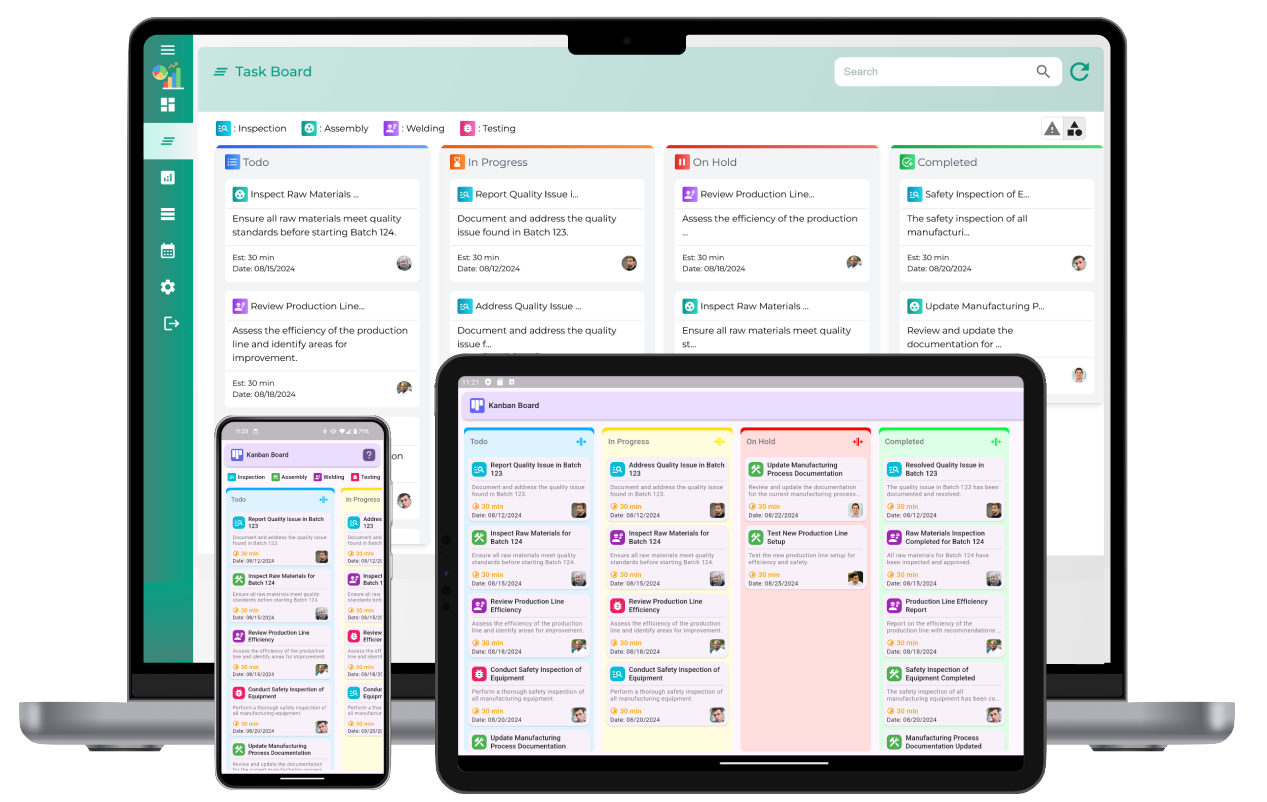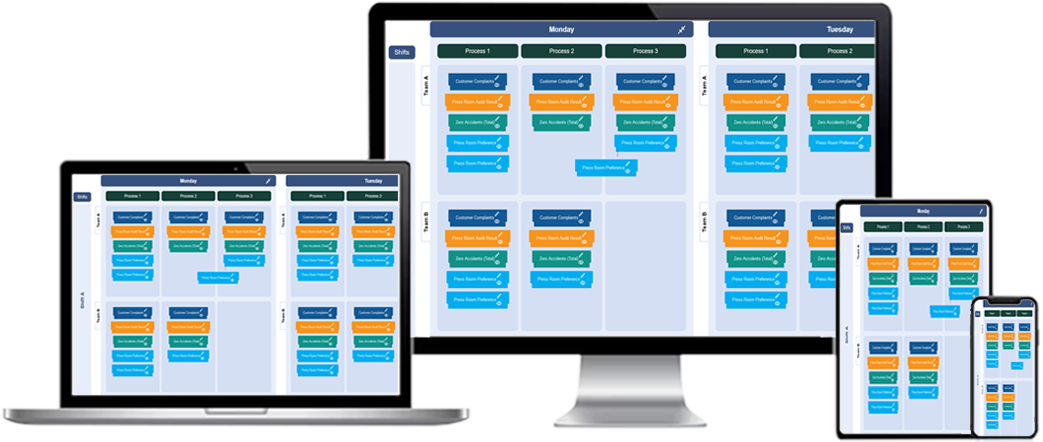In today’s fast-paced work environment, task management tools play a vital role in organizing workflows and improving team productivity. Among the most popular options for visual task management are the Kanban board and the TCard board. While both offer a visual way to track tasks, they come with distinct features and methods of operation. Understanding these differences is key to selecting the right tool for your team or organization’s specific needs.

What is a Kanban Board?
The Kanban board is a visual task management system rooted in the principles of lean manufacturing and just-in-time production. The name "Kanban" originates from the Japanese word for "visual signal," and the system itself is designed to optimize workflows by visually organizing tasks and limiting the amount of work in progress at any given time. It typically consists of columns such as "To Do," "In Progress," and "Done," with each column representing a different stage in the workflow process. Tasks, represented by cards, are moved across these columns as they progress through each stage.
One of the key principles of the Kanban system is the limitation of work-in-progress (WIP). This concept ensures that no one stage of the workflow becomes overwhelmed, thereby promoting smoother transitions and better focus. Kanban boards can be adapted for personal use or scaled for larger teams and complex projects. They are especially beneficial for teams using agile methodologies or those needing to manage continuous workflows.

What is a TCard Board?
A TCard board is another visual task management tool, but it is often simpler and more flexible in its design compared to a Kanban board. TCard boards use physical or digital cards, called TCards, to represent tasks or work items. These cards are typically moved between columns to indicate their progress, similar to the Kanban system. However, TCard boards can be customized to fit a variety of workflows and may include additional columns to represent specific stages, departments, or priorities, depending on the needs of the organization.
Unlike the Kanban board, TCard boards often provide more versatility in how tasks are organized. For instance, tasks can be color-coded, or additional information such as due dates, priority levels, and assigned team members can be added to the TCards. While Kanban boards typically focus on limiting WIP, TCard boards are more focused on flexibility and adaptability, offering teams more control over how they manage tasks and projects.
Key Differences Between Kanban and TCard Boards
1. Workflow Structure
The most notable difference between Kanban boards and TCard boards is how workflows are structured. Kanban boards are built on the principle of limiting WIP and maintaining a steady flow of tasks through clearly defined stages. This ensures that team members can focus on finishing tasks before starting new ones. TCard boards, on the other hand, are typically more flexible and can be adjusted to suit a variety of project workflows, from simple task management to complex project timelines.
2. Level of Customization
TCard boards are highly customizable and can be tailored to fit the specific needs of any organization. For instance, additional columns, labels, or categories can be added to the board to represent various stages or departments. This makes TCard boards more adaptable to diverse projects, including manufacturing, inventory control, or sales tracking. In contrast, Kanban boards typically follow a more standardized format, with fewer customization options. While Kanban boards can be adapted to different workflows, they are best suited for teams focused on agile development or those with clear and straightforward processes.
3. Complexity and Ease of Use
Kanban boards tend to have a more structured and streamlined layout, which makes them easier to use for teams with clear, repetitive workflows. They are great for managing ongoing processes and ensuring that tasks are completed in a logical sequence. However, this simplicity may not be ideal for projects that require a high level of customization or complex task categorization.
TCard boards, on the other hand, are often seen as more complex due to their high level of customization. While this offers greater flexibility, it can also make TCard boards more difficult to set up and manage for teams unfamiliar with the tool. The added complexity of TCard boards may be better suited for organizations with varied workflows that require detailed task tracking and prioritization.
4. Flexibility and Use Case
Kanban boards are highly effective for teams that need to manage continuous workflows or agile projects. The visual nature of the board, combined with the WIP limitation, helps teams stay focused and avoid becoming overwhelmed. Kanban boards are particularly well-suited for software development teams, customer service, or any environment that values efficiency and speed. They are also easy to set up and use, which makes them ideal for smaller teams or those new to visual task management.
TCard boards, on the other hand, offer greater flexibility for managing more complex or varied workflows. TCard boards can be used in manufacturing, project management, inventory control, and other areas where tasks need to be tracked across different stages, priorities, and categories. The ability to customize columns and cards makes TCard boards suitable for organizations that need more control over their processes. They can also be more easily adapted to non-digital environments, allowing for manual tracking and updating when necessary.
Benefits of Kanban Boards
- Visual organization: Tasks are clearly represented and easy to track across stages.
- Focus on flow: WIP limits ensure that tasks move smoothly through each stage without bottlenecks.
- Adaptability: Kanban boards can be used in various industries, from software development to marketing and beyond.
- Simplicity: Kanban boards are straightforward and easy to implement, requiring minimal setup.
Benefits of TCard Boards
- High customization: TCard boards can be tailored to meet the unique needs of any project or organization.
- Versatility: TCard boards can be used in a wide range of industries, from manufacturing to project management.
- Detailed task tracking: Tasks can be categorized and tracked in multiple ways, allowing for greater control.
- Flexibility: TCard boards can be adapted to various physical and digital formats for easy management.
Kanban Board vs Tcard board for visual task management
What is a Kanban Board?
A Kanban board is a visual tool used to manage work by organizing tasks into columns that represent different stages of the workflow, typically with a focus on limiting work-in-progress (WIP).
What is a TCard Board?
A TCard board is a visual task management system that uses colored cards to represent tasks, which are moved through columns representing various stages of the workflow or process.
What are the differences between Kanban boards and TCard boards?
The main difference is in the design and flexibility. Kanban boards focus on continuous flow with work-in-progress limits, while TCard boards are more flexible, often used for visualizing task stages and simpler workflows.
How does a Kanban board work?
In a Kanban board, tasks are represented by cards that move across columns (such as "To Do," "In Progress," and "Done") to reflect their current status, with a focus on limiting WIP to ensure smoother workflow.
How does a TCard board work?
A TCard board uses color-coded cards to represent tasks. These cards are placed in columns that represent the stages of the process, and they are moved across the board as the tasks progress.
Which is more flexible: Kanban or TCard boards?
TCard boards are generally more flexible, allowing for a wide range of task management styles and workflows, while Kanban boards are more structured with defined columns and WIP limits.
Can both Kanban and TCard boards be used for personal productivity?
Yes, both boards can be used for personal productivity. Kanban boards help manage work flow with an emphasis on limiting WIP, while TCard boards offer a more customizable approach to organizing personal tasks.
What industries benefit from using Kanban boards?
Industries such as software development, manufacturing, healthcare, and project management benefit from Kanban boards due to their focus on efficiency, task flow, and continuous improvement.
What industries benefit from using TCard boards?
TCard boards are beneficial in industries like project management, event planning, logistics, and inventory management, where flexibility and visual tracking are key to success.
How do Kanban and TCard boards improve team collaboration?
Both Kanban and TCard boards improve team collaboration by providing a visual representation of tasks, enabling easy communication, and ensuring everyone is aligned on the work in progress.
What are the benefits of using Kanban boards over TCard boards?
Kanban boards are particularly effective at visualizing work flow, limiting WIP, and ensuring smooth task transitions. They are ideal for teams focused on continuous improvement and lean project management.
What are the advantages of using TCard boards over Kanban boards?
TCard boards are more flexible and customizable, allowing teams to adjust the board layout and workflow to fit specific needs. They are also easier to set up and can be used for simpler task management systems.
How do Kanban and TCard boards visualize work?
Both Kanban and TCard boards use visual elements such as cards and columns to represent tasks and workflow stages. Kanban boards typically focus on limiting WIP and visualizing flow, while TCard boards offer a more customizable, simple task management approach.
Can Kanban and TCard boards help manage workflow in manufacturing?
Yes, both boards can help manage workflow in manufacturing. Kanban boards focus on optimizing the flow of work, reducing bottlenecks, and increasing efficiency, while TCard boards can be used for tracking stages and organizing tasks in manufacturing processes.
Which is better for managing tasks in a project: Kanban or TCard boards?
The choice depends on the project needs. Kanban boards are better for teams that require a structured workflow with WIP limits, while TCard boards are better for simpler, more flexible project management with customizable workflows.